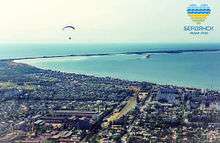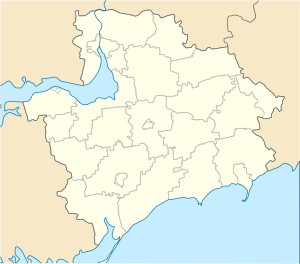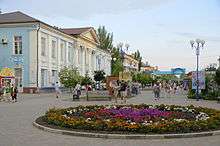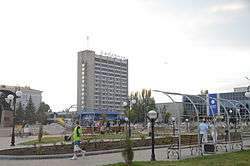Berdyansk
Berdyansk or Berdiansk (Ukrainian: Бердя́нськ, romanized: Berdiansk, Russian: Бердя́нск, romanized: Berdyansk) is a port city in the Zaporizhia Oblast (province) of south-east Ukraine. It is on the northern coast of the Sea of Azov, which is the northern extension of the Black Sea. It serves as an administrative center of Berdiansk Raion (district), though it does not belong to the raion. The city is named after the river Berda forming Berdyanska spit at the foot of which it is located.[2] Berdyansk is a very attractive place, home to a safari zoo, water park, museums, health resorts with mud baths and climatic treatments, and numerous water sport activities.
Berdiansk Ukrainian: Бердянськ Russian: Бердянск | |
|---|---|
 | |
 Flag | |
 Berdiansk Location of Berdyansk  Berdiansk Berdiansk (Ukraine) | |
| Coordinates: 46°45′35″N 36°47′04″E | |
| Country | |
| Oblast | |
| Raion | Berdyansk City Municipality |
| Founded | 1841 |
| City rights | 1841 |
| Government | |
| • Mayor | Vladimir Chepurnoy |
| Area | |
| • Total | 82.65 km2 (31.91 sq mi) |
| Elevation | 10 m (30 ft) |
| Population (2019[1]) | |
| • Total | 110,455 |
| • Density | 1,300/km2 (3,500/sq mi) |
| Postal code | 71100-71127 |
| Area code(s) | (+380) 6153 |
| Vehicle registration | AP/08 |
| Climate | Cfa |
| Website | City Council Official website |
Name
Its original name was Kutur-Ogly. The city name changed to Novo-Nogaisk in 1830 (New Nogaisk) (see Nogai). The present name was given to the city in 1841 by special decree of Nicholas I and named after the nearby river Berda.
Between 1939 and 1958 the city was known as Osipenko, so named after Hero of the Soviet Union Polina Osipenko.[3] This name has now been given to the nearby village Osypenko, where Polina Osipenko was born.
History
Berdyansk grew from a small settlement and a pier, built in 1673 by Zaporozhian and Azov Cossacks.[4]
In the 19th century, the Russian Imperial government began to plan building a sea port in the Northern Azov region. In 1824, Count Mikhail Vorontsov, Governor General of the Caucasus Viceroyalty, sent an expedition to the Azov Sea. Its task was to find a place to build a new seaport to assist in the defence of Russia's southern borders. Initially, the place for a future port was implied in the village of Obetochnoe that belonged to Count Orlov-Denisov, near the town of Nogaysk founded in 1821.[5]
In the autumn of 1824 Captain N. Kritsky, the expedition supervisor, reported on several prospective sites; the best being a place closed off from the sea by the Berdyansk Spit. In an official report to Vorontsov, Kritsky wrote: "the quality of Berdyansk Spit surpasses that of Obytichna Spit; you can build a landing stage and port on it unless you concede to Sevastopol...".[6]
In 1820s, the place of the future Berdyansk was just a small settlement of fishers with a few huts[7] In 1825, merchant Nikolay Kobozev built a private wooden quay which was opened with a ceremony on July 1, 1830.[8] Only by January 12, 1835, a state-owned quay had been built.[8] In 1833, Nikolay Kobozev set up a wooden post to function as a navigation beacon; the modern stone lighthouse was built under the leadership of the Italian merchant Carlo Tomasini in 1838.[5] It is a 23-metre (75 ft) octahedral whitestone tower with an orange stripe in the middle. The beacon fires protected sailing ships and was first seen in 1840. Almost half a century later, in 1883, the oil lamps were replaced by electric lights. The old beacon was refurbished and upgraded with newer equipment.
In 1836 the first foreign ship entered the port of Berdyansk.[5]
In 1841 the settlement at the Berdyansk bay received the city status. Grigory Chernyaev (1787—1868) was appointed the city governor (gradonachalnik) and the head of the Berdyansk sea port.[9] G. Chernyaev was an officer from landed gentry; he took part in the Battle of Borodino.[9] After the defeat of Napoleon he was appointed a comendant of Valenciennes.[9] Michael Vorontsov knew him from France, when the former was the commander of the Russian expedition forces.[9]
The son of the Nogaysk merchant who owned fisheries at the Berdyansk bay, Nikolay Kobozev was elected the first mayor of the city in 1841. During his office, the small township had turned into a flourishing city with a large number of foreign companies' offices and active international trade. He had built the first stone houses in the town and the famous Winter Theater, destroyed during WWII.
1842 Berdyansk became the district center. On January 31, 1845, the first Berdyansk coat of arms was created. At the top, on a green field, is a silver Nogay's nomadic tent together with a black plow; this denotes the semi-nomadic life lived in the Nogays and farming work done by local residents. In the bottom part, on a blue field, sits a black anchor to symbolize the district's affinity with the sea. By this time the customs outpost was already opened. Some foreign marine grain purchasing representatives (negotiators) moved their offices to Berdyansk from Mariupol and Odessa.
Following the completion of the Crimea Bridge, and amidst hostile Ukrainian-Russian relations, Berdyansk sea port authority stated in November 2018 that year on year shipping had dropped 50%.[10] This, they claim, was due to ships not getting permission from Russia to pass through the Kerch strait.[10] Russia denied any disruption to Ukrainian shipping.[10]
Development
The city developed and grew, though construction was random and haphazard. In the center, private residences for the nobility, merchants, priests were built, as well as office accommodation. Suburbs arose in the outskirts of Berdyansk, such as: Sailor, German, Soldier (Liska), Dog beam Havrylivka, and Near and Far Makorty.
In April 1862 Tsar Alexander II with assistance from the Mayor N. Kobozev confirmed the city district plan for Berdyansk. In the plan the streets were straight and led to the sea. This layout has remained to the present day in the central part of the city. It was forbidden to build houses above the second floor. Fine buildings decorate Berdyansk: the Winter Theatre, City Hall, the hotel "Bristol" (now House of Culture factory "Pivdenhidromash"), male classical school (now the main building of the Pedagogical Institute), Ascension Cathedral, the Lutheran Church and more.
In Berdyansk the main employer was still the seaport, and on March 24, 1869 the breakwater was commissioned. This stone building is 640 metres (2,100 feet) long with two port lights on the ends – pointers to the harbor, located at a distance of 859 metres (2,818 feet) from the shore. The increasing importance of the port was mentioned in 1867 in a commemorative book on the Taurian province: "Already there is no doubt, that for all the Azov coast the Berdyansk port will be the Odessa of the Black Sea coast".
In 1876 as part of the defense of Sevastopol, rear admiral P. P. Schmidt was appointed Town Governor and Port Chief. Being a progressive man, he did much to promote the development of both port and city. Soon there were small industrial enterprises and banks opening in the city. John Greaves' factory manufacturing harvesters became well known across Europe.[11][12] A farming machine factory was opened by Schröder and Matias. There was the rope-making factory of Venz and Yanzen, Selstrem's candle-wax works, Litsmen sausage factory, Fetter's brewery, Klavdin macaroni factory, and Ediger's printing house. The Italians constructed the city power station. By this time, two daily newspapers, three libraries and four bookshops were established. The city had running water and electric light illumination.
In 1899 Berdyansk was linked up to the railway. At the beginning of the 20th century the city population numbered 26,500. There were about ten orthodox temples, two Jewish and one Karaite synagogue, boys and girls grammar schools, nautical classes, a city college and some credit institutions. In addition to an extensive export trade in mainly grain and flour,[13] Berdyansk conducted large amounts of inland trade. It became a substantial distributive market for goods received over a wide area. By the beginnings of the 20th century, Berdyansk had become a merchant trading port with well developed industry, strongly influenced by its infrastructure. In 1915 a French Consul, and the Vice-Consuls of Great Britain, Greece, Denmark, Spain, Italy, Sweden, and Norway, were in Berdyansk.[14]
Geography
Berdyansk is located in a steppe zone that defines its varieties of flora and fauna. The climate on the Azov coast is unique: the summers are hot and dry, the winters are mild and warm. The main natural feature is the end of the Berdyansk spit. The spit flora is quite diverse. Here one can find more than 300 different kinds of plants. Some of them are documented in the Red Book (e.g. Carex colchica, Eryngium maritimum, Glycyrrhiza glabra). The vegetation is mostly made up of plants with powerful root systems.
In spite of the fact that the spit is a populous territory, it exhibits a wide variety of fauna. Here it is possible to see hares, hedgehogs, martens, foxes, weasels and steppe cats. There also are: geese, sandpipers, swans, herons, ducks, magpies, seagulls, cormorants, warblers, lapwings, red-breasted geese and mute swans. Their numbers swell during the migration season. The islands of Big Dzendzik and Small Dzendzik, small islands in the Astapih's archipelago, contain most of the birds.
Sea water temperatures off Berdyansk are higher than the Black Sea coast of the Crimea and the Caucasus. Already in May, the water warms up to 22 °C (72 °F), and in June it can reach 30 °C (86 °F). In the sea there are more than 70 fish species amongst them great sturgeon, Russian sturgeon, starred sturgeon, Azov turbot, haarder, mullets, kilka, anchovy, sea roach, shemaya and various species of gobies. There are predators too, pike perch and sterlet. The phytoplankton consists of diatomaceous, peridinium and cyanobacteria algae. At the bottom of the sea are large quantity of molluscs, such as cockles, sendesmiya, mussels and myas. They form an important food source for the fish. In coastal waters there are also dolphins.
Demographics
| Historical population | ||
|---|---|---|
| Year | Pop. | ±% |
| 1860 | 10,100 | — |
| 1897 | 26,500 | +162.4% |
| 1926 | 26,400 | −0.4% |
| 1939 | 52,000 | +97.0% |
| 1959 | 65,000 | +25.0% |
| 1970 | 100,000 | +53.8% |
| 2001 | 121,000 | +21.0% |
Note: Historical population record is taken out of Encyclopedia of Ukraine.[15]
Culture
In the city of Berdyansk there are several art museums, Schmidt's Museum, Museum of World War II and Berdyansk History Museum. It is a host city to more than ten festivals a year. The list includes:
- the Azov Summer Ukrainian Journalism Festival
- the Brigantine Film Festival
- the Berdyansk Jazz Festival
- the Hilarious by the Dark Blue Sea Comedy Festival
- the Top-Top Children's Talent Festival
- the Starfall Children's Pop Music Festival
- Berdyansk Folk and Religious Music Festival
- the Heat of the Sun Festival
- the Azov Sails Televised Children's Talent Festival
- the Rock'n'roll Slavic Soul Festival,
- the Beer Festival




.jpg)
Monuments
Berdyansk has unusual monuments. Along with monuments to Alexander Pushkin and Schmidt there are monuments to the goby-supporter, the sanitary technician, the boy-fisherman, an envious toad, and the children of lieutenant Schmidt. The armchair of desires is also popular. It is said if one sits down on it and thinks of a desire then it will come true. These unusual monuments are being restored on Azov avenue.
 Fish eater monument in Berdiansk
Fish eater monument in Berdiansk Villagers monument on the city market
Villagers monument on the city market envious toad
envious toad
Tourism
The status of the city has gradually changed from an Industrial centre to more of a tourist centre. Today Berdyansk is the main resort city on the Azov coast. Its population numbers about 130,000, and during the resort season this figure rises to about 600 thousand. The leisure facilities are highly developed and successfully compete with resorts on the Black Sea Coast and the Crimea. There are a large number of sanatoriums and resorts where it is possible to take medical and restorative courses for "health improvement".
On the Berdyansk spit there are about: 7 sanatoriums, 17 children's and sports establishments, 45 recreation centres and boarding houses that receive up to 15 thousand persons. There is also the biggest Aquapark in Europe, the Kiev dolphinarium, a safari zoo, and a lot of pleasure and cultural establishments. Gradually Berdyansk is evolving into a modern European city. In 2001 it received first place in an All-Ukrainian competition for best city beautification.
In the pedestrian area of Azov Avenue, the Seaside square and Berdyansk quays it is possible to travel on trishaws, a small steam locomotive and on real horses. On all beaches there are entertainments such as: driving on rubber bananas and tablets, water bicycles and motorcycles, slides and trampolines, and sailing. There is also nightlife, with many bars and restaurants located directly on the sea coast.
Economy
One of the main enterprises is the sea trading port, with clients from all over the world. It carries out metal processing, scrap metal, grain, coal, ore, clay, sunflower-seed oil, industrial oils, mineral oil, and pig-iron. There is a complex for processing fertilizers and mineral oil, the container terminal, and a railway depot. Tracks and roads approach all moorings, and all are equipped with electric cranes. Depth in port water area is 8.4 metres (28 feet).
Berdyansk is also an important fisheries centre which is an integral part of the city's food industry. There is also a scientific organisation which does fish research in reservoirs of the Azov basin. It determines stock levels and calculates the annual volumes of withdrawal of such valuable food fish as sturgeon, pike perch, haarder, Azov turbot, Azov gobies, and flounder.[16]
Industry
During the Soviet period Berdyansk was a powerful industrial centre. There were machine factories of all types, an oil refinery, a fiberglass factory, cable factory, ferroconcrete combine, factory of materials handling equipment, provisions factory, a bread-baking complex, milk plant, a meat-packing plant, a considerable quantity of construction and mounting organizations, commodity railway station and the sea trading port. However, in the early independence years the majority of the large industrial enterprises ceased or were reorganised into smaller private concerns.
Chemical and the petroleum-refining industry is represented by two big enterprises: "AZMOL", and the Berdyansk state fiberglass factory, plus two small enterprises: Limited Liability Company "Fibreglass" and Closed Corporation "Bertie". Public corporation"AZMOL"is engaged in the manufacture of lubricants and packaging, and the development of new products using energy-efficient technologies. Transfer to municipal ownership of the city biological sewage treatment plant is planned.
Education
As well as the state comprehensive schools there are private lyceums and gymnasiums, as well as branches of other high schools and professional colleges. There is the Berdyansk State Pedagogical University and the University of Management and Business. In the Schmidt park there is the Berdyansk musical school, and nearby, almost on the coast, an art school. A subject of pride in Berdyansk is the Centre of Children's and Youthful Creativity, numbering a large quantity of study groups and ensembles.
According to Ben Eklof in Russian Peasant Schools, education in Berdiansk was badly disrupted in the 1870s when the schools director, a government inspector, 'ran amok' and had to be removed from his post.
Notable people
- Peter Jansen (1852–1923), born in Berdyansk, rancher and founder of Jansen, Nebraska, State Representative and Senator
- Opanas Slastion (1855–1933), painter
- Waldemar Haffkine (1860–1930), bacteriologist
- Joel Engel (1868—1927), music critic and composer
- Isaak Brodsky (1883–1939), Soviet-Jewish painter
- Polina Osipenko (1907–1939), Soviet military pilot, was born in a nearby village of Osypenko
- Mikhail Voskresensky (born 1935), Russian pianist
- Tatyana Prorochenko (born 1952), athlete, Olympic champion (in 1976 and 1980)
- Olga Kurylenko (born 1979), model and actor
Twin towns – sister cities
Berdyansk is twinned with:[17]











References
- Чисельність наявного населення України на 1 січня 2019 року. Державна служба статистики України. Київ, 2019. стор.33
- "Berdyansk city, Ukraine travel guide". ukrainetrek.com. Retrieved 2016-12-17.
- Осипенко, Полина Денисовна, Wikipedia
- (in Ukrainian) "7 Wonders": the best historic towns of Ukraine, BBC Ukrainian (10 November 2016)
- Порт при сей косе...
- "History :: Berdyansk City Council – Official". bmr.gov.ua. Retrieved 2016-12-17.
- Население. Известные личности. Династии.Энциклопедия Бердянска. — С. 122-123.
- Сукач Г. О том, когда же начинается история Бердянского морского порта, и об уроках истории, которые так ничему и не научили (11.12.2017).
- "Газета "Город" - Первый градоначальник Бердянска был одним из героев Отечественной войны 1812 года". gorod-online.net.
- 'Danger never went away': Ukrainian cities feel cornered by Russia, The Guardian (30 November 2018)
- Lyman Igor, Konstantinova Victoria, Danchenko Eugene. British Consul and Industrialist John Edward Greaves (Berdyansk, 2017), 200 p.
- Lyman Igor, Konstantinova Victoria. British Vice-Consul in Berdyansk John Edward Greaves, Scriptorium nostrum (2016, № 2 (5)), pages 86-108
- Victoria Konstantinova, Igor Lyman and Ignatova Anastasiya. European Vector of the Northern Azov in the Imperial Period: British Consular Reports about Italian Shipping (Berdyansk: Tkachuk O.V., 2016), 184 p.
- Igor Lyman, Victoria Konstantinova. The Ukrainian South as Viewed by Consuls of the British Empire (Nineteenth - Early Twentieth Centuries). Volume 1: British Consuls in the Port City of Berdyansk (Kyiv, 2018), 630 p.
- "Berdiansk". www.encyclopediaofukraine.com.
- "Welcome to Azov Center YugNIRO! - Azov Center YugNIRO". 18 July 2010. Archived from the original on 18 July 2010.
- "Партнерські зв'язки". bmr.gov.ua (in Ukrainian). Berdyansk. Retrieved 2020-04-01.
External links
![]()
